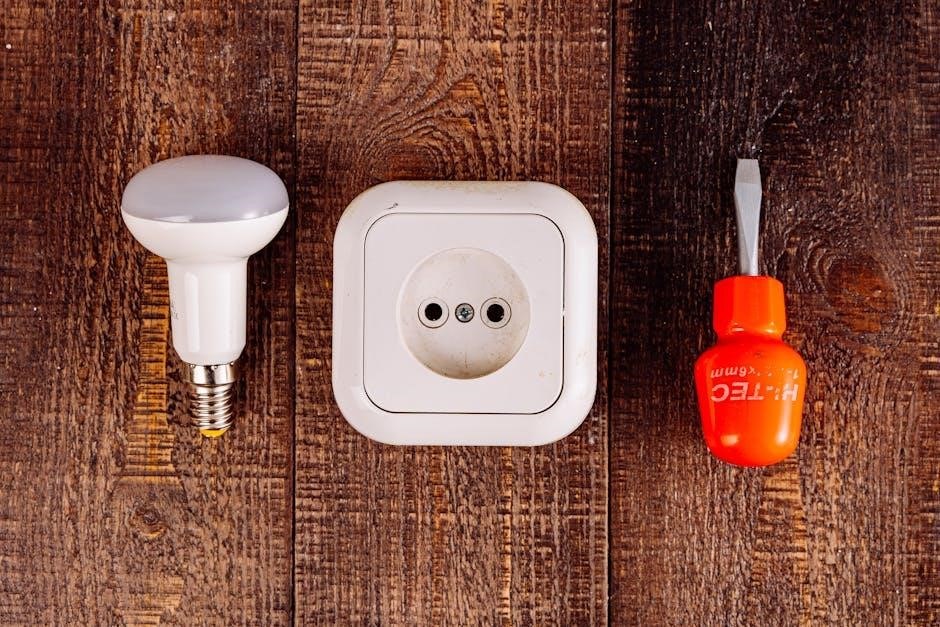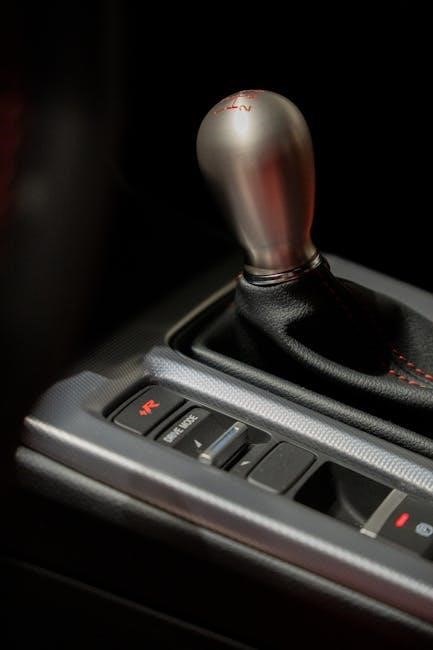Safety Precautions
1.1 Important Safety Tips
- Avoid using the Power Probe 3 near flammable materials like gasoline or vapors.
- Never use the device with 110/220-volt household current; it’s designed for 12-24V systems only.
- Keep the probe tip away from your body to prevent electrical shock.
- Do not touch electrical components while testing to avoid short circuits.
- Always read the Power Probe 3 instruction manual carefully before use to ensure safe operation.
- Avoid using the device near flammable materials, such as gasoline or its vapors, as sparks may ignite them.
- Never use the Power Probe 3 with 110/220-volt household current; it is designed exclusively for 12-24V DC systems.
- Keep the probe tip away from your body to prevent accidental electrical shock.
- Ensure the device is disconnected from the battery when not in use to prevent unintended power discharge.
- Do not touch electrical components while testing to avoid short circuits or damage to the device.
- Wear protective gloves and eyewear when working with electrical systems.
These precautions ensure safe and effective use of the Power Probe 3 for automotive diagnostics.
The Power Probe 3 is a versatile diagnostic tool designed for 12-24V automotive systems, offering advanced features like a digital voltmeter, audio tone functionality, and multiple operating modes.
2.1 Overview of the Power Probe 3
The Power Probe 3 is a professional-grade diagnostic tool designed for automotive electrical systems. It functions as a circuit tester, digital voltmeter, and power source, making it ideal for troubleshooting 12-24V systems. The device features three primary modes: Probe Mode, Hook Mode, and Voltage Mode, each tailored for specific testing needs. Equipped with a 20-foot power cable and a 3-inch probe tip, it provides flexibility and precision. Additional features include an auxiliary ground connection and an audio tone function for hands-free testing. The PP3 is compact, durable, and user-friendly, ensuring efficient diagnostics in various automotive scenarios. Its robust design and advanced capabilities make it an essential tool for technicians and enthusiasts alike.
2.2 Features and Benefits
The Power Probe 3 offers a range of innovative features designed to enhance diagnostic efficiency. It includes three operating modes: Probe Mode for direct testing, Hook Mode for circuit activation, and Voltage Mode for precise voltage measurement. The device also features an auxiliary ground connection for accurate testing and an audio tone function for hands-free operation. With a 20-foot power cable and a 3-inch probe tip, it provides extended reach and precision. The PP3 supports 12-24V systems, making it suitable for automotive and heavy-duty applications. Additional benefits include a built-in digital voltmeter, LED indicators, and a durable design for long-term reliability. These features make the Power Probe 3 an indispensable tool for technicians and enthusiasts, ensuring efficient and accurate diagnostics.

Installation and Setup
Install the Power Probe 3 by connecting the red clip to the positive battery terminal and the black clip to a grounded metal surface. Ensure proper connections for accurate testing and safe operation.
3.1 Connecting to the Battery
To connect the Power Probe 3 to the battery, attach the red clip to the positive terminal and the black clip to the negative terminal or a grounded metal surface. Ensure clips are secure to maintain proper contact. Avoid touching electrical components during connection to prevent short circuits. Once connected, the device will perform a quick self-test, indicated by a high and low beep, and enter Power Probe Mode (PPM). Always refer to the manual for detailed instructions and safety precautions to ensure safe and effective testing. Proper connection is essential for accurate readings and device functionality.
3.2 Auxiliary Ground Connection
To ensure accurate testing, connect the auxiliary ground clip to a clean, bare metal surface on the vehicle’s chassis or a known good ground point. This provides a stable reference for the Power Probe 3. Avoid connecting to rusty or painted surfaces, as this may lead to unreliable readings. Secure the clip firmly to maintain proper contact. The auxiliary ground connection is crucial for activating components and measuring voltage effectively. Always ensure the area is clear of debris before attaching the clip. This step is essential for safe and precise diagnostics with the Power Probe 3. Proper grounding prevents false readings and potential damage to the device or vehicle systems.
- Use a clean, bare metal surface for the auxiliary ground.
- Avoid rusty or painted areas for optimal conductivity.
- Ensure the clip is securely attached to prevent accidental disconnection.
3.3 Quick Self-Test
The Power Probe 3 performs a quick self-test when first connected to the battery. Upon connection, it emits a high-pitched beep followed by a low-pitched beep, indicating the device is operational. The two bright white LEDs will illuminate briefly to confirm proper functionality. This test checks the probe tip, LEDs, and audio tone. If the LEDs do not light or the beeps are irregular, check the battery connections. Ensure the auxiliary ground clip is securely attached to a clean, bare metal surface. A failed self-test may indicate a poor ground connection or low battery voltage. Repeat the test to confirm device readiness before proceeding with diagnostics.
- Connect the device to the battery to initiate the self-test.
- Verify the high-low beep sequence and LED illumination.
- Check connections if the test fails and retry.

Operating Modes
The Power Probe 3 operates in three primary modes: Probe Mode, Hook Mode, and Voltage Mode. Each mode offers distinct diagnostic capabilities for electrical system testing.
- Probe Mode: Activates components directly from the battery for live testing.
- Hook Mode: Measures voltage at specific points without powering components.
- Voltage Mode: Functions as a digital voltmeter for precise voltage readings.
4.1 Probe Mode
Probe Mode allows users to activate electrical components directly from the battery, enabling live testing of circuits and components. When the Power Probe 3’s switch is depressed, it conducts battery current and voltage to the probe tip, simulating a direct power source. This mode is ideal for diagnosing faulty components by observing their operation under live conditions. However, caution is advised, as this can cause sparks when contacting ground or certain circuits. Always ensure the area is clear of flammable materials. The probe tip glows red when positive voltage is applied, providing clear visual feedback during testing.
4.2 Hook Mode
Hook Mode on the Power Probe 3 allows users to test voltage in a circuit by connecting the probe tip to a voltage potential. This mode is essential for diagnosing electrical systems and identifying faults. To use Hook Mode, connect the Power Probe to a good battery and clip the auxiliary ground lead to a known ground source. Contact the probe tip to the circuit under test and observe the voltage reading on the display. The device will sound a tone and light up LEDs to indicate positive or negative voltage. This mode is particularly useful for tracing voltage drops and verifying circuit integrity without applying external power. Always ensure proper connections to avoid incorrect readings or damage to the device.
4.3 Voltage Mode
Voltage Mode on the Power Probe 3 enables users to measure voltage in a circuit without applying external power. This mode is ideal for diagnosing electrical systems by verifying the presence and level of voltage. To use Voltage Mode, connect the probe tip to the circuit under test while the auxiliary ground lead is securely attached to a known ground source. The device will display the voltage reading on its screen, and the LED indicators will show whether the voltage is positive or negative. This feature is particularly useful for identifying voltage drops, testing fuses, and checking battery voltage. Always ensure the probe is in contact with the correct terminal to avoid inaccurate readings and potential damage to the device or circuit.
Advanced Features
The Power Probe 3 includes advanced features like an integrated digital voltmeter for precise voltage measurements and an audio tone function for hands-free circuit testing, enhancing diagnostic efficiency.
5.1 Audio Tone Functionality
The Power Probe 3 features an audio tone function that simplifies circuit testing by providing audible feedback. This hands-free feature allows users to diagnose wiring issues without constant visual monitoring. When activated, the device emits distinct tones to indicate the presence of power, ground, or open circuits. A continuous tone signals a positive connection, while an intermittent tone may indicate a negative or open circuit. This feature is particularly useful for tracing wires and identifying faults in complex electrical systems. The audio tone can be easily enabled or disabled using a dedicated switch, offering flexibility for different testing scenarios. This functionality enhances efficiency and accuracy during diagnostic procedures, making it an essential tool for technicians and automotive enthusiasts alike.
5.2 Digital Voltmeter
The Power Probe 3 incorporates a built-in digital voltmeter, enabling precise voltage measurements in 12-24V systems. This feature is crucial for diagnosing electrical issues, such as low battery voltage, faulty alternators, or incorrect wiring. The digital display provides clear and accurate readings, allowing users to quickly identify voltage drops or discrepancies. The voltmeter operates in conjunction with the probe tip and auxiliary ground, ensuring reliable results. By measuring voltage directly at the source, technicians can pinpoint problems efficiently. This tool is invaluable for troubleshooting complex electrical circuits and ensures that systems operate within specified voltage ranges, preventing potential damage to components. The digital voltmeter enhances the device’s versatility, making it a comprehensive solution for automotive diagnostics.

Troubleshooting Common Issues
- Check for loose connections or corroded clips to ensure proper conductivity.
- Verify battery voltage is within 12-24V range for optimal performance.
- Inspect the probe tip for damage or wear that may cause inaccurate readings.
- Ensure the auxiliary ground is securely connected to avoid false results.
- Refer to the manual for resetting or recalibrating the device if issues persist.
6.1 Common Problems and Solutions
- No Power: Ensure the device is properly connected to a 12-24V battery. Check for loose or corroded connections and verify the power switch is in the correct position.
- Inaccurate Readings: Calibrate the device as per the manual or reset it if necessary. Ensure the probe tip is clean and free from damage.
- Probe Tip Damage: Replace the probe tip if damaged. Avoid using excessive force, which may bend or break the tip.
- False Voltage Readings: Check the auxiliary ground connection. Ensure it is securely attached to a clean, metal surface.
- Audio Tone Malfunction: Turn the device off and on again. If the issue persists, consult the manual for troubleshooting steps.
These common issues can often be resolved with basic troubleshooting steps outlined in the manual. Always refer to the guide for detailed solutions.

Maintenance and Storage
7.1 Cleaning and Storage Tips
- Clean the probe tip regularly with a soft cloth to ensure proper conductivity.
- Store the device in a dry, cool place away from direct sunlight.
- Avoid extreme temperatures and humidity to maintain optimal performance.
- Use the provided storage case to protect the probe and accessories.
To maintain the Power Probe 3’s performance, regular cleaning and proper storage are essential. Clean the probe tip with a soft, dry cloth to remove dirt or corrosion. For stubborn oxidation, lightly sand the tip and wipe clean. Avoid harsh chemicals, as they may damage the components. Store the device in a protective case to prevent scratches and damage. Keep it in a cool, dry place away from direct sunlight or moisture. Check the cable for signs of wear or damage and replace it if necessary. Use silica gel packets to absorb humidity in storage. Always organize accessories like clips and adapters to ensure they remain functional. Proper care extends the lifespan of your Power Probe 3 and ensures reliable operation.
Accessories and Included Items
The Power Probe 3 comes with essential accessories to enhance its functionality and convenience. Included items are a 20ft power cable, 3-inch probe tip, battery clip set, cigarette lighter adapter, and an instruction manual.
8.1 What’s in the Box
The Power Probe 3 package includes a comprehensive set of accessories to ensure optimal functionality. Inside the box, you will find the Power Probe 3 device itself, a 20-foot (6 meters) power cable for extended reach, a 3-inch (8 cm) probe tip for precise testing, a battery clip set for secure connections, and a cigarette lighter adapter for convenient power supply in vehicles. Additionally, the package includes an instruction manual, which provides detailed guidance on using and maintaining the device. These accessories are thoughtfully curated to enhance your diagnostic experience, offering versatility and ease of use for various automotive and electrical testing scenarios.

Wiring Diagrams and Examples
The manual provides detailed wiring diagrams to help users understand circuit connections. Examples include testing voltage, checking trailer lights, and diagnosing common automotive issues. Clear labels guide users through complex setups, ensuring accurate and safe testing procedures.
9.1 Sample Wiring Tests
The Power Probe 3 instruction manual includes step-by-step guides for common wiring tests. These examples help users diagnose issues like faulty circuits, blown fuses, or incorrect voltage. One example demonstrates how to test trailer light wiring by connecting the probe to the trailer hitch and activating the vehicle’s brake and turn signals. Another example shows how to identify short circuits by probing live wires while the vehicle is in operation. The manual also provides diagrams for testing auxiliary power outlets and verifying ground connections. These samples ensure users can confidently apply the Power Probe 3 to real-world automotive electrical systems, making troubleshooting faster and more accurate.

Getting Started with Basic Tests
Connect the Power Probe 3 to the battery and use the probe tip to test circuits. Activate components with the power switch and verify voltage with the digital voltmeter. Use the LED indicators to confirm power and ground connections, ensuring accurate diagnostics for your vehicle’s electrical system. Follow the manual’s step-by-step guide to master basic testing procedures quickly and safely;
10.1 First-Time User Guide
Unroll the Power Probe 3 cable and connect the red clip to the battery’s positive terminal and the black clip to the negative terminal. Perform a quick self-test by turning on the device, which will emit a high then low beep, indicating it’s ready for use. In Probe Mode, touch the probe tip to circuit components to test voltage. Use Hook Mode to activate components directly. The digital voltmeter will display voltage readings, and the LED lights will indicate power and ground connections. Always test in a well-ventilated area, away from flammable materials, and avoid touching electrical components to prevent shock. Follow these steps to ensure safe and effective testing of your vehicle’s electrical system.

Real-World Applications
The Power Probe 3 is widely used in automotive diagnostics to test voltage, activate components, and trace wiring faults efficiently. It’s a vital tool for mechanics and professionals.
11.1 Case Studies and Examples
The Power Probe 3 has proven invaluable in various real-world scenarios. For instance, in diagnosing a faulty brake light circuit, technicians used the probe to isolate the issue to a corroded connector. Another example involved identifying a blown fuse in a trailer wiring system by activating components directly from the battery. The tool’s ability to apply power and ground simultaneously simplified troubleshooting. Mechanics have also utilized it to test voltage at sensors and actuators, ensuring proper system functionality. These case studies highlight the Power Probe 3’s efficiency and accuracy in resolving complex automotive electrical issues, making it an essential tool for professionals and DIY enthusiasts alike.

Technical Specifications
The Power Probe 3 operates on 12-24V DC systems, features a 20ft (6m) power cable, and includes a 3-inch (8cm) probe tip. It supports auxiliary ground connections and has an 8amp thermal circuit breaker for added safety.
12.1 Device Capabilities
The Power Probe 3 is a versatile diagnostic tool designed for 12-24V DC systems, offering advanced features like voltage testing, current activation, and component-level diagnostics. It includes a 20ft (6m) power cable, a 3-inch (8cm) probe tip, and an auxiliary ground connection. The device supports audio tone functionality for circuit tracing and has a built-in digital voltmeter for precise voltage measurements. With an 8amp thermal circuit breaker, it ensures safe operation during testing. The Power Probe 3 is compatible with various automotive systems, making it an essential tool for technicians and DIY enthusiasts alike. Its compact design and robust construction enhance reliability and ease of use in diverse applications;

Comparison with Other Models
The Power Probe 3 stands out among its competitors like the PP3S and ECT2000, offering enhanced features such as improved voltage testing and advanced audio tone functionality for circuit diagnostics. The PP3S includes additional connectivity options, while the ECT2000 focuses on specialized testing for heavy-duty applications. The Power Probe 3 remains the most versatile and user-friendly option for automotive diagnostics.
13.1 PP3 vs. PP3S vs. ECT2000
The Power Probe 3 (PP3) is a versatile diagnostic tool designed for automotive use, offering voltage testing, audio tone functionality, and a digital voltmeter. The PP3S enhances the PP3 with additional features like a cigarette lighter adapter and extended cable options, making it ideal for professionals. In contrast, the ECT2000 is tailored for heavy-duty applications, providing advanced circuit testing and durability for industrial environments. While the PP3 is perfect for standard automotive diagnostics, the PP3S offers more convenience, and the ECT2000 excels in specialized scenarios. Each model caters to different user needs, ensuring there’s a Power Probe solution for every diagnostic requirement.
Downloading the Instruction Manual
Visit the official Power Probe website, navigate to the support section, and search for the PP3 manual. Download the PDF version for free. It’s available in multiple languages for easy access.
14.1 Steps to Download
To download the Power Probe 3 instruction manual, visit the official Power Probe website. Navigate to the “Support” or “Downloads” section. Search for the PP3 manual using the model number or product name. Select the appropriate language and click the download link. The manual is available in PDF format and can be saved to your device for easy access. If the official website is unavailable, visit trusted sites like ManualsLib.com or ManualsDir.com, which host user manuals for various devices. Ensure the file is free from malware by downloading from reputable sources only. The manual includes detailed instructions, diagrams, and troubleshooting guides to help you use your Power Probe 3 effectively.

Leave a Reply
You must be logged in to post a comment.